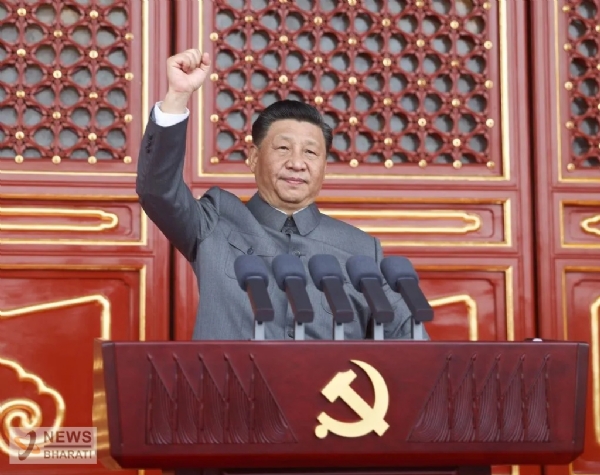Common Prosperity with Chinese Characteristics
It seeks to reduce income inequality in China by way of wealth redistribution. This policy is intricately linked not only to shortcomings of China’s economic transformation in the last four decades, but also with the overall legitimacy of the communist party.
Total Views | 113
Recently, there were reports that senior officials working in China’s US$ 58 trillion financial sector have been witnessing higher pay cuts in efforts to reduce the pay gap between senior and junior officials. This is a part of larger policy preference followed by Xi Jinping which is called as ‘Common Prosperity’ (共同富裕 gòngtóng fùyù). In fact, the concept of common prosperity is included in China’s second centennial goal of building ‘a modern socialist country’ by 2049.

It seeks to reduce income inequality in China by way of wealth redistribution. This policy is intricately linked not only to shortcomings of China’s economic transformation in the last four decades, but also with the overall legitimacy of the communist party.
Common prosperity is not a new concept in China’s political discourse. It was very much in vogue during the Mao period. However, it took a backseat during Deng Xiaoping’s reform and opening up era. Under Xi Jinping, it has again become popular as economic reforms have also brought various kinds of disparities based on income levels, regions, gender and so on. For instance, in 2019, the average disposable per capita income in Shanghai is more than double to what it was in inland provinces like Gansu. As per 2022 figures, there are 698 billionaires in China, only after the USA with 724 billionaires. Over the past 20 years, China's Gini coefficient, which ranges from 0 to 1 with 0 representing perfect equality, has stayed between 0.40 and 0.49 in the past two decades, which is significantly higher. Similarly, unemployment rates have also been on the rise in the last few years, which can potentially pose a threat to internal stability in China. Thus, common prosperity is not only important for economic equality but also for political stability. Xi has promised to eradicate such disparities and establish a ‘well regulated’ wealth accumulation system. Although China had announced last year that it had eradicated absolute poverty, the income inequality still remains large in China. Thus, Xi Jinping stressed this issue even during his speech at the recent national party congress. Although the government has not come out with a specific policy, it is largely being considered as a prerequisite for successfully running a business in China. Xi’s anti-corruption campaign is also largely focused on regulating the newly established ‘bourgeoise’ class in China. The recent measures include putting a limit on maximum pay as well as deliberately deferring bonuses and other incentives. Foreign companies operating in China will also be affected by these measures. In another instance, the Asset Management Association of China (AMAC) had recently issued guidelines suggesting asset management companies to create a ‘reasonable’ pay system and to avoid excessive rewards. Other measures like anti-monopoly laws and crackdown on technological companies in recent times can also be interpreted as efforts taken to realise common prosperity goals. In order to avoid the government's crackdown, many billionaires and large private companies have preferred to fall in line with Xi’s policies and have offered unusually huge charities in the last two years. As per China philanthropy list, 49 top benefactors have donated around US$ 10 billion between April to August 2021. Nonetheless, how these donations reach the underprivileged and how that improves income equality, are still to be answered. In 2021, Xi Jinping selected China’s third richest Zhejiang province as a pilot demonstration zone for common prosperity. Zhejiang is not only important as a coastal province but also a home to numerous tech companies like Alibaba. The policy stated that Zhejiang must achieve common prosperity by 2035 through the development of the middle-income population and by raising per capita GDP at par with developed economies. The focus of this policy is largely on providing benefits of economic development to middle-income and underprivileged population. The Chinese academia is divided on this policy. While many scholars emphasize the need to have such a policy to successfully complete China’s transition to a developed economy, there are some scholars who have raised concerns over its implementation. Professor Zhang Jun of Fudan University warned that the policy might end up in ‘common poverty’ if wealth redistribution is not supplemented by economic growth. Economist Li Daokui also suggested that the government should ensure that common prosperity does not drag down economic development and reduce overall efficiency. This threat can actually come true if growth-less wealth redistribution might discourage the capitalist class in China to invest more, thus pushing China into a vicious cycle. Considering China’s recent economic slowdown, this situation might arrive sooner than expected if China insists on arbitrarily continuing this policy.
If this policy achieves success, it can also help China to improve its global image and put aside censure for human rights violations in Xinjiang and Tibet, at least for a brief period. However, there are numerous challenges in achieving this objective. The severity of these challenges is quite evident from the fact that, unlike most other objectives, China hasn't ascribed any deadline for realising common prosperity. Thus, China has to manage this policy in a way where economic and political costs do not outweigh social benefits. Xi Jinping, in his historic third term as the General Secretary of CCP, has a daunting task ahead of him to find this equilibrium.
Bharati Web
Mes, Pune








